Look no further if you desire opulence and grandeur in a majestic residence, as these incredible palaces in India offer the epitome of decadence. While castles and forts also grace our list, the majority consists of awe-inspiring, immense, and stunning palaces.
Of course, you’re familiar with the renowned Taj Mahal, but it represents just one example of the exceptional Indian architecture.
1. The Victoria Memorial
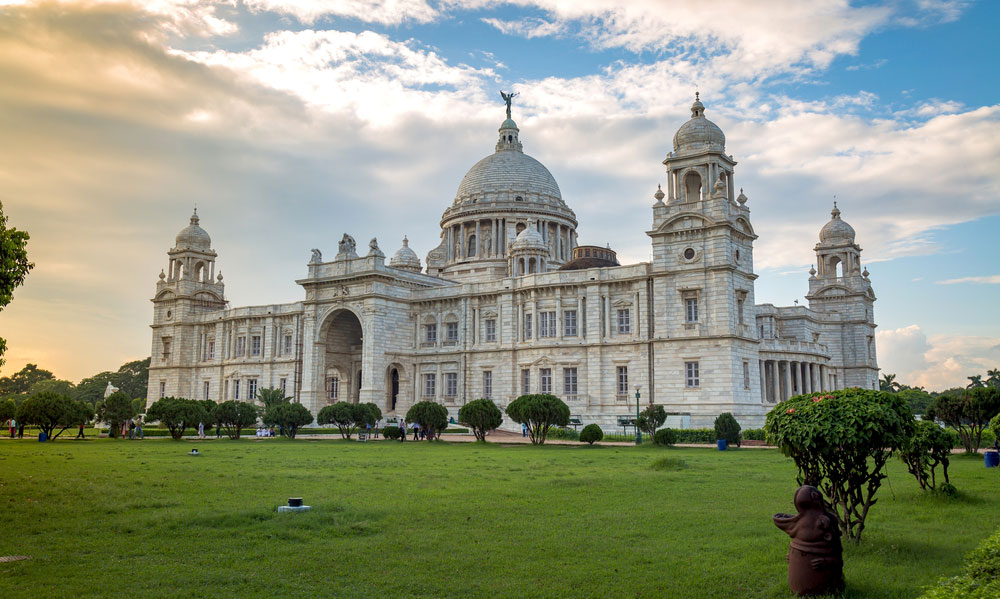
An awe-inspiring edifice crafted from marble resides in Kolkata, West Bengal, India—the Victoria Memorial. Constructed between 1906 and 1921, this monument stands as a dedication to Queen Victoria’s memory. William Emerson designed it in the Indo-Saracenic revivalist style, while the construction was led by Messrs. Martin & Co. of Calcutta.
Details of the Victoria Memorial
Location: Calcutta, India
Erected: 1906-1921
Architect: William Emerson
Architectural style: Indo-Saracenic revivalist style
Current function: Museum
Owned by: Government of West Bengal
2. Umaid Bhawan Palace

Behold the Umaid Bhawan Palace, one of the largest privately owned residences worldwide. Nestled in Jodhpur, Rajasthan, India, this palace emerged between 1928 and 1943, commissioned by King Umaid Singh. Architect Henry Vaughan Lanchester oversaw the construction, employing the Beaux Arts style, also known as Indo-Deco style. Presently, this palace serves three purposes: it is the royal family’s residence, a luxurious Taj Palace Hotel, and a museum that chronicles the 20th-century history of the Jodhpur Royal Family.
Details of Umaid Bhawan Palace
Location: Jodhpur, India
Built: 1928-1943
Architect: Henry Vaughan Lanchester
Architectural style: Beaux Arts style (Indo-Deco style)
Current functions: Residence of the royal family / Taj Palace Hotel / Museum
Owned by: Gaj Singh
3. Udaivilas Palace

The Oberoi Udaivilas, a luxury hotel that earned the title of the world’s best hotel in 2015 by Travel + Leisure, graces the city of Udaipur, Rajasthan, India. This opulent hotel emerged in the 19th century, occupying the former hunting grounds of the Maharana of Mewar.
Details of Udaivilas Palace
Location: Udaipur, India
Erected: 19th century
Architect: N/A
Architectural style: N/A
Current function: Luxury hotel
Owned by: N/A
4. Taj Mahal
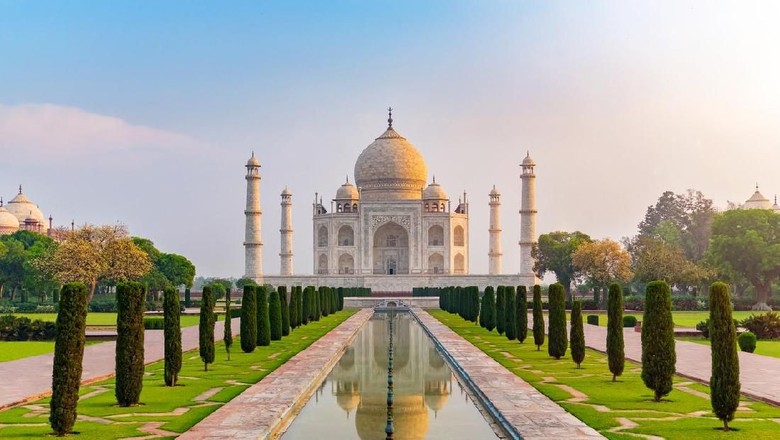
The Taj Mahal, one of the most renowned UNESCO World Heritage Sites and a member of the Seven Wonders of the World, stands as an ivory-white marble mausoleum on the banks of the Yamuna River in Agra, India. Mughal emperor Shah Jahan commissioned its construction in 1632 as a tribute to his beloved wife, Mumtaz Mahal. Often referred to as the jewel of Muslim art in India, this architectural masterpiece represents an esteemed symbol of India’s rich history and Mughal architecture.
Details of the Taj Mahal
Location: Agra, India
Built: 1632-1653
Builder: Mughal emperor Shah Jahan
Architectural style: Mughal architecture
Current functions: UNESCO World Heritage Site / Seven Wonders of the World
Owned by: Indian Government
5. Royal Rajwada Palace

The Holkars of the Maratha Empire constructed the historical Rajwada Palace in the 18th century within Indore city. This palace showcases the Indo-Saracenic Maratha style, serving as a testament to royal grandeur and architectural prowess.
Details of the Royal Rajwada Palace
Location: Indore, India
Built: 18th century
Builder: Holkars of the Maratha Empire
Architectural style: Indo-Saracenic Maratha style
Current function: Historical palace museum
Owned by: The Khasgi Ahilyabai Holkar Charities Trust
6. Red Fort Lal Qila
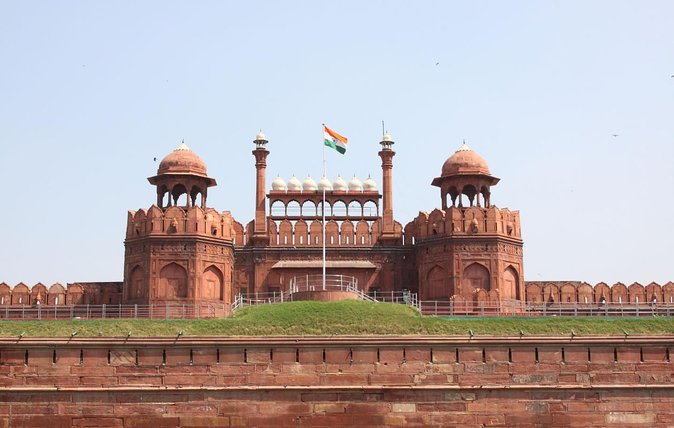
The Red Fort, a historic fortification located in Old Delhi, India, served as the primary residence for Mughal emperors. Built between 1639 and 1648 by the fifth Mughal Emperor Shah Jahan, this magnificent structure follows Indo-Islamic and Mughal architectural styles. Nowadays, it stands proudly as a UNESCO World Heritage Site and a captivating tourist attraction.
Details of the Red Fort Lal Qila
Location: Old Delhi, India
Built: 1639-1648
Builder: 5th Mughal Emperor Shah Jahan
Architectural style: Indo-Islamic style / Mughal architecture
Current functions: UNESCO World Heritage Site / Tourist attraction
Owned by: Indian Government
7. Rashtrapati Bhavan
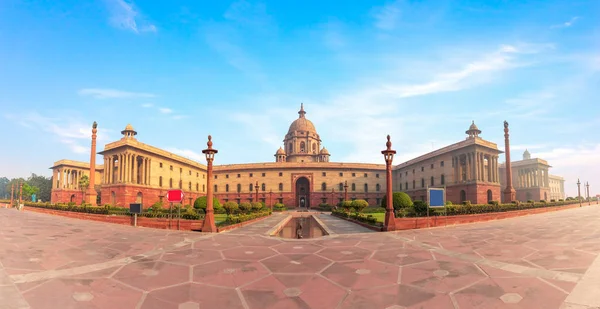
Previously known as Viceroy’s House, the Rashtrapati Bhavan in New Delhi, India, serves as the official residence of the President of India. Constructed from 1912 to 1929, the building’s architectural plans were led by British architect Edwin Landseer Lutyens in the Delhi Order architectural style.
Details of the Rashtrapati Bhavan
Location: New Delhi, India
Built: 1912-1929
Architect: Edwin Landseer Lutyens
Architectural style: Delhi Order architectural style
Current function: Presidential House
Owned by: Indian Government
8. Mysore Palace

The Mysore Palace, situated in Mysore, Karnataka, India, is a historical palace and royal residence named after the city itself. Originally built in the 14th century in Hindu architectural style, the Old Palace faced destruction due to a devastating fire. However, it was reconstructed in 1897, culminating in its completion in 1912 under the guidance of British architect Lord Henry Irwin. The palace now represents a magnificent example of Indo-Saracenic architecture and stands as one of India’s most renowned tourist attractions, second only to the majestic Taj Mahal.
Details of the Mysore Palace
Location: Mysore, India
Built: 1897-1912
Architect: Lord Henry Irwin
Architectural style: Indo-Saracenic style
Current function: Tourist attraction
Owned by: Indian Government
9. Mehrangarh Fort

Dominating the cityscape of Jodhpur, Rajasthan, India, the Mehrangarh Fort stands as one of the country’s largest forts. Built in the 15th century by Rao Jodha, the ruler of Mandore and the founder of Jodhpur, this imposing structure showcases a rich heritage. It features seven gates, with Jai Pol, Fateh Pol, Dedh Kamgra Pol, and Loha Pol being the most renowned. The fort also houses a museum displaying palanquins, howdahs, royal cradles, miniatures, musical instruments, costumes, and furniture. Additionally, it exhibits the Rathores’ legacy through weaponry, costumes, paintings, and ornate period decorations.
Details of Mehrangarh Fort
Location: Jodhpur, India
Built: 15th century
Builder: Rao Jodha
Architectural style: N/A
Current function: Open to
the public
Owned by: Indian Government
10. Laxmi Vilas Palace

The Laxmi Vilas Palace served as the residence of the royal family of Baroda and was erected by Maharaja Sayajirao Gaekwad III. Major Charles Mant took charge as the chief architect, and the palace’s construction commenced in 1890. The architectural design blends elements of Indo-Saracenic Revival style, resulting in a magnificent structure. To this day, the palace remains the residence of the Gaekwad royal family.
Details of the Laxmi Vilas Palace
Location: Baroda, India
Built: 1890
Architect: Major Charles Mant
Architectural style: Indo-Saracenic Revival style
Current function: Residence of the Gaekwad royal family
Owned by: Gaekwad royal family
11. Laxmi Niwas Palace
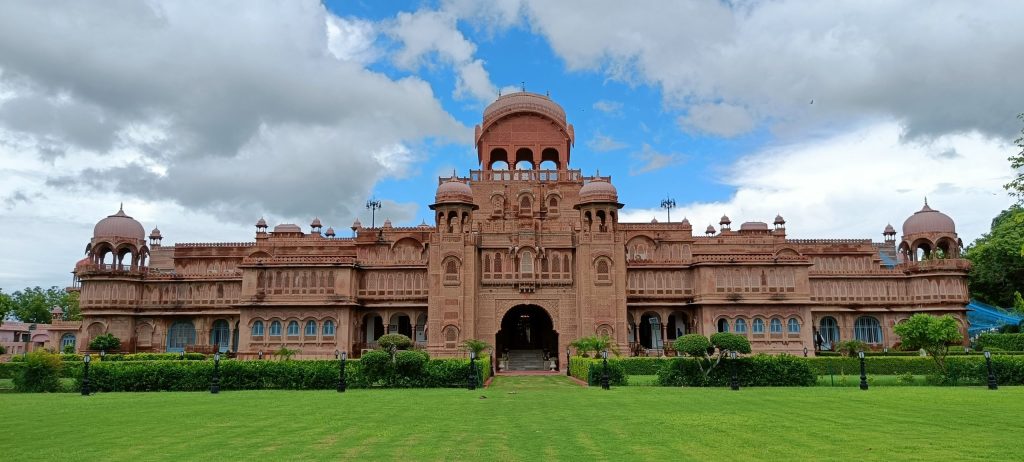
Commissioned by Maharajah Sir Ganga Singh, the Laxmi Niwas Palace was constructed between 1898 and 1902 to serve as his royal residence. Sir Samuel Swinton Jacob designed this palace in the Indo-Saracenic style. However, in the 21st century, it ceased to be the royal family’s residence and underwent conversion into a luxurious hotel under the ownership of Golden Triangle Fort & Palace P. Ltd.
Details of the Laxmi Niwas Palace
Location: Bikaner, India
Built: 1898-1902
Builder: Maharajah Sir Ganga Singh
Architectural style: Indo-Saracenic style
Current function: Luxury hotel
Owned by: Golden Triangle Fort & Palace P. Ltd.
12. Taj Lake Palace
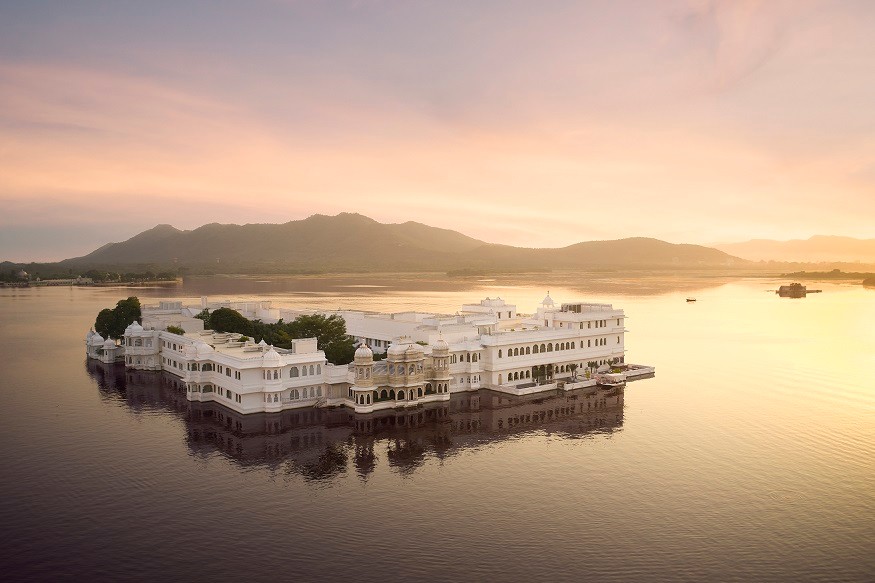
Originally serving as a summer palace for the Mewar royal dynasty, the Taj Lake Palace was constructed between 1743 and 1746. Maharana Jagat Singh II of Mewar, inspired by the Rajput architectural style, oversaw its design. For years, the palace remained under the management of the Mewar Dynasty. However, in 1971, it transitioned into a luxury hotel, now operated by Taj Hotels Resorts and Palaces.
Details of the Taj Lake Palace
Location: Udaipur, India
Built: 1743-1746
Builder: Maharana Jagat Singh II of Mewar
Architectural style: Rajput architecture
Current function: Luxury hotel
Owned by: Taj Hotels Resorts and Palaces
13. Jaswant Thada
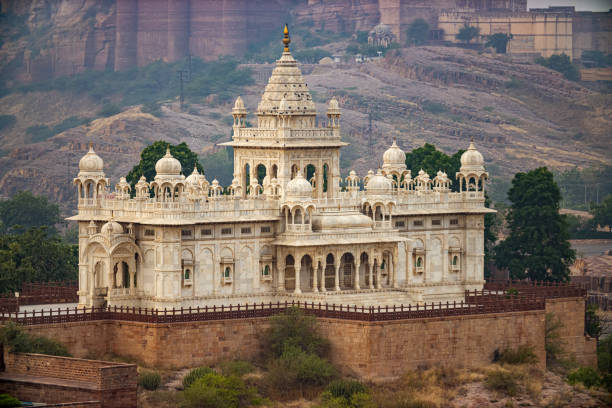
Jaswant Thada, an elegant cenotaph in Jodhpur, was built in 1899 by Maharaja Sardar Singh of Jodhpur State as a memorial to his father, Maharaja Jaswant Singh II. Constructed from intricately carved marble sheets, this delicate structure emits a warm glow when illuminated by sunlight.
Details of Jaswant Thada
Location: Jodhpur, India
Built: 1899
Builder: Maharaja Sardar Singh of Jodhpur State
Architectural style: Mughal architecture
Current function: Cremation ground for the royal family of Marwar
Owned by: Royal family of Marwar
14. Jal Mahal

The Jal Mahal, meaning “Water Palace,” is an architectural gem showcasing the Rajput style. Constructed in 1596 by Maharaja Madho Singh I, it initially served as the Maharaja’s hunting lodge. However, during the 16th century, a severe drought struck the region, compelling the construction of a dam around the lodge and submerging its lower section. In the 18th century, the area underwent renovation, expanding it and transforming it into a lake. The Jal Mahal is currently privately owned, with plans for its conversion into a restaurant.
Details of the Jal Mahal
Location: Jaipur, India
Built: 16th century
Builder: Maharaja Madho Singh I
Architectural style: Rajput architecture
Current function: Privately owned
Owned by: Private owner
15. Jai Vilas Palace

Also known as Jai Vilas Mahal, the Jai Vilas Palace emerged as a nineteenth-century masterpiece in Gwalior, India. Constructed by Maharajadhiraj Shrimant Jayajirao Scindia Alijah Bahadur, the Maharaja of Gwalior, it served as the royal family’s residence. Presently, it continues to be occupied by the descendants of the former royal Maratha Scindia dynasty. The palace boasts a combination of Italian, Corinthian, and Tuscan architectural styles, designed by Sir Michael Filose.
Details of the Jai Vilas Palace
Location: Gwalior, India
Built: 19th century
Builder: Maharajadhiraj Shrimant Jayajirao Scindia Alijah Bahadur, the Maharaja of Gwalior
Architectural style: Italian, Corinthian, and Tuscan architecture
Current function: Still residence of the former royal Maratha Scindia family
Owned by: Jyotiraditya Scindia
16. Jahaz Mahal

Famously known as the “Ship Palace,” the Jahaz Mahal stands adjacent to Hauz-i-Shamsi in Mehrauli, Delhi. This structure was believed to have been built during the Lodi dynasty period to provide accommodation to a multitude of pilgrims visiting Delhi’s Muslim shrines from Afghanistan, Arabia, Iran, Iraq, Morocco, and Turkey. Another purpose of the Jahaz Mahal was to serve as a summer retreat for emperors Akbar Shah II and Bahadur Shah II, along with their families, seeking respite from Delhi’s scorching heat and dust.
Details of the Jahaz Mahal
Location: Delhi, India
Built: 1452–1526
Builder: Mughal Dynasty
Architectural style: Mughal architecture
Current function: In ruins
Owned by: Indian Government
17. Jag Mandir Palace

Located on an island in Lake Pichola, the Jag Mandir, also known as the “Lake Garden Palace,” was built by Maharana Jagat Singh I in 1551. Completed in the mid-17th century, this palace held significant importance to Prince Khurram, who later became Emperor Shah Jahan. It is said to have served as the inspiration for one of the world’s most magnificent wonders—the Taj Mahal.
Details of Jag Mandir Palace
Location: Udaipur, India
Built: 1551
Builder: Maharana Jagat Singh I
Architectural style: Rajput architecture
Current function: Luxury Hotel
Owned by: Arvind Singh Mewar
18. Hawa Mahal
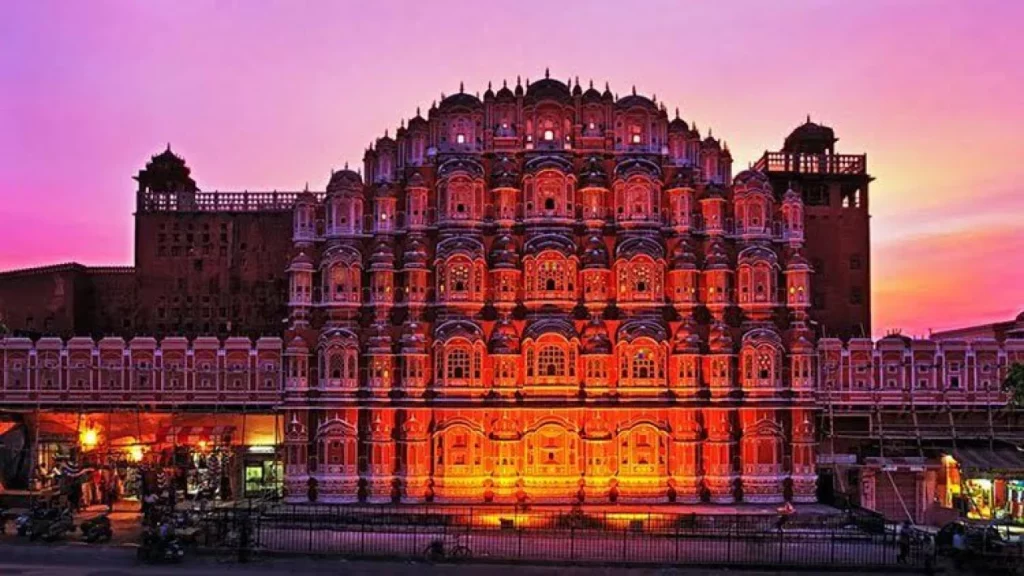
Situated on the edge of the City Palace in Jaipur, the Hawa Mahal extends to the zenana, or women’s chambers. Maharaja Sawai Pratap Singh constructed this architectural marvel in 1799, employing Rajput style architecture to allow the royal household’s ladies to observe the city’s life and processions.
Details of the Hawa Mahal
Location: Jaipur, India
Built: 1799
Builder: Maharaja Sawai Pratap Singh
Architectural style: Rajput architecture
Current function: Historical monument
Owned by: Indian Government
19. Falaknuma Palace
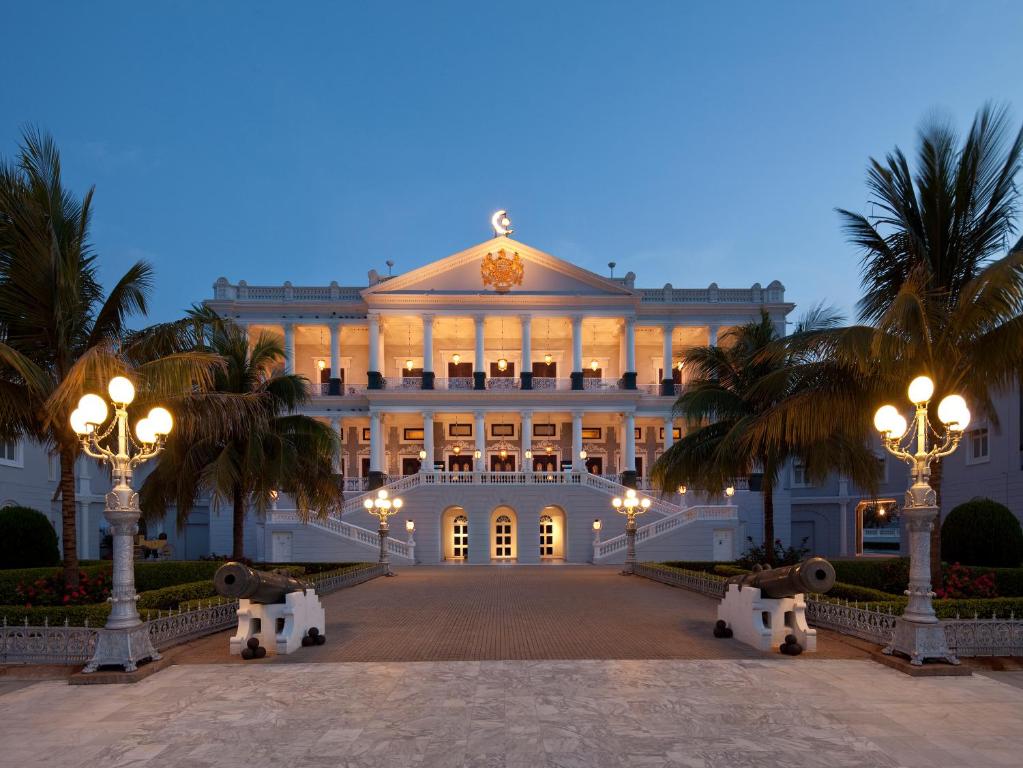
The Falaknuma Palace, located in Hyderabad,
India, originally belonged to the Paigah family and was later acquired by Nawab Sir Viqar-ul-Umra, the Prime Minister of Hyderabad. Constructed between 1884 and 1893, the palace served as Sir Viqar-ul-Umra’s private residence. The architectural design followed the Palladian style and was led by William Ward Marrett. Today, the Falaknuma Palace operates as a luxury hotel under the ownership of Mukarram Jah.
Details of the Falaknuma Palace
Location: Hyderabad, India
Built: 1884-1893
Builder: Sir Viqar-ul-Umra
Architectural style: Palladian style
Current function: Luxury hotel
Owned by: Mukarram Jah
20. Darwaza-i-Rauza

The Darwaza-i-Rauza, one of the components of the Taj Mahal complex, encompasses the mausoleum, mosque, and guest pavilion. Also known as the Great Gate, this mausoleum was constructed by Ustad Ahmad Lahauri under the orders of Shah Jahan between 1631 and 1653. It holds a significant position as a UNESCO World Heritage Site.
Details of the Darwaza-i-Rauza
Location: Agra, India
Built: 1631-1653
Builder: Shah Jahan
Architectural style: Mughal architecture
Current function: Mausoleum / UNESCO World Heritage Site
Owned by: Indian Government
21. City Palace in Udaipur
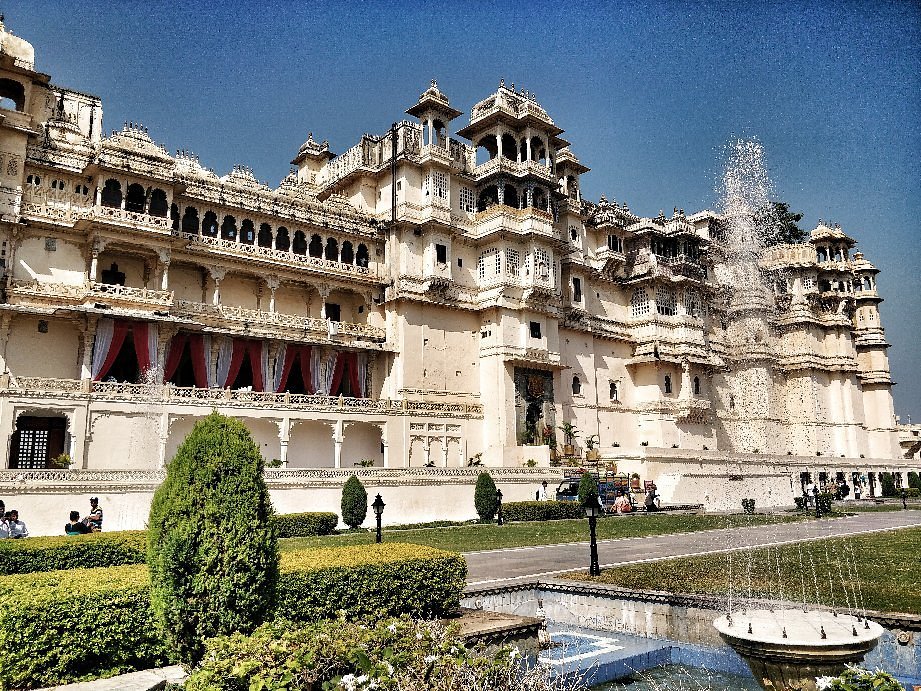
The City Palace of Udaipur, situated in Udaipur, Rajasthan, dates back to the 16th century and was constructed by Maharana Udai Singh II, the city’s founder. Reflecting the grandeur of Rajput architecture, the City Palace opened its doors to the public as the City Palace Museum in 1969, preserving its glorious form.
Details of the City Palace of Udaipur
Location: Udaipur, India
Built: 16th century
Builder: Maharana Udai Singh II
Architectural style: Rajput architecture
Current function: City Palace Museum / Open to the public
Owned by: Arvind Singh Mewar and Mahendra Singh Mewar
22. Bangalore Palace
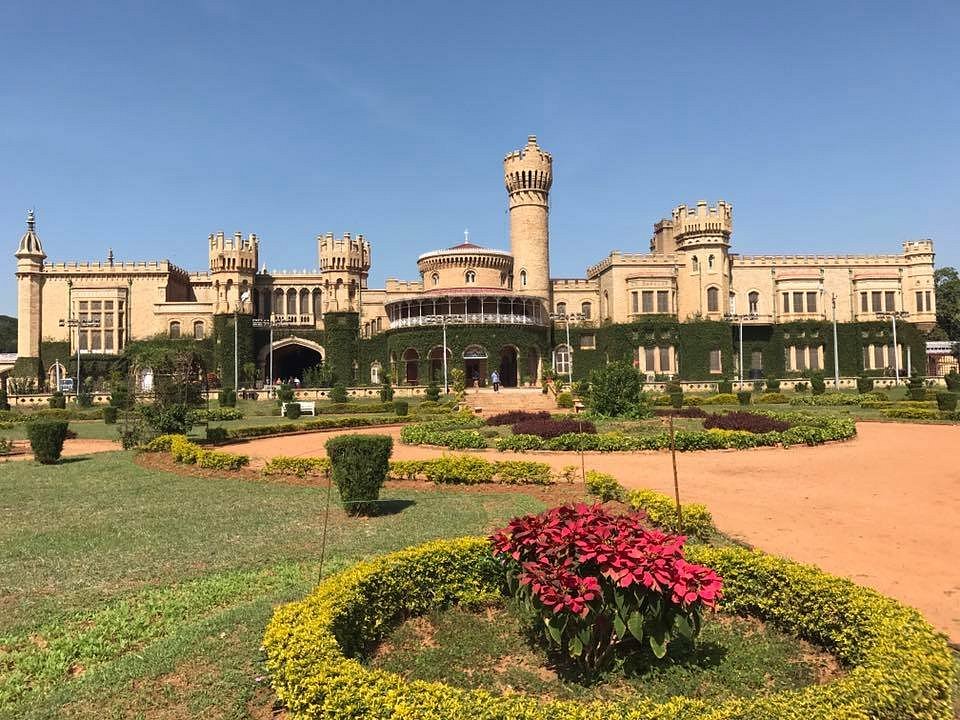
The Bangalore Palace, located in Bangalore, Karnataka, India, is renowned for its striking Tudor Revival style architecture. The exact identity of the architect remains uncertain. The property was purchased by the British Guardians of the minor Maharaja Chamarajendra Wadiyar X from Rev. J. Garrett, who owned the land on which the palace stands. Utilizing personal funds, Chamarajendra Wadiyar’s British Guardians transformed the palace into a magnificent blend of Tudor and Scottish Gothic architecture that continues to captivate visitors today.
Details of the Bangalore Palace
Location: Bangalore, India
Built: 1878
Builder: Chamarajendra Wadiyar’s British Guardians
Architectural style: Tudor Revival style
Current function: Tourist attraction
Owned by: HH Pramoda Devi Wadiyar
23. Amber Fort

The Amber Fort, situated in Amer, Rajasthan, India, is an artistic fusion of Rajput and Mughal architecture. Its construction commenced in 1592 and was built atop the ruins of a former fort that served as the residence of Rajput rulers. Over time, successive rulers made modifications and enhancements, transforming the fort into the remarkable structure it is today. The Amber Fort is currently part of the UNESCO World Heritage Site.
Details of the Amber Fort
Location: Jaipur, India
Built: 1592
Builder: Maharaja Man Singh I
Architectural style: Mix of Rajput and Mughal architecture
Current function: UNESCO World Heritage Site / Open to the public
Owned by: Government of Rajasthan
24. Aga Khan Palace
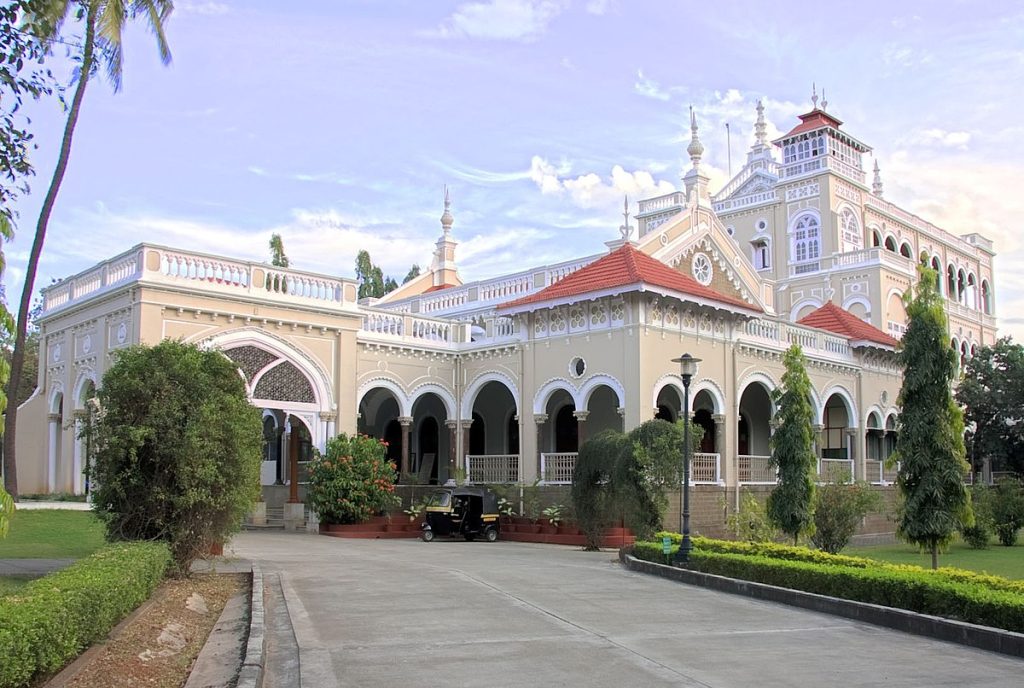
Located in Pune, India, the Aga Khan Palace was erected in 1892 by Sultan Muhammed Shah Aga Khan III. The palace gained historical significance as it served as the internment site for Mahatma Gandhi and other prominent nationalist leaders during the British rule’s Quit India campaign in 1942. Legend has it that Sultan Muhammed Shah Aga Khan III constructed this palace as an act of charity to help the impoverished people of Pune, who were severely affected by famine. He employed 1000 individuals to construct the palace.
Details of the Aga Khan Palace
Location: Pune, India
Built: 1892
Builder: Sultan Muhammed Shah Aga Khan III
Architectural style: Mughal architecture
Current function: Headquarters of the Gandhi National Memorial Society / Monument of National Importance
Owned by: Indian Nation